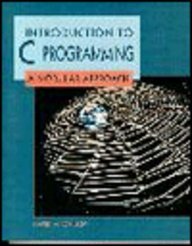
Synopsis
Assuming the reader has little or no programming background and no math beyond basic algebra, Introduction to C Programming: A Modular Approach, takes a "learn by example" approach to C programming. It introduces one or more "realistic" sample programs in each chapter to illustrate how the material may be applied to an actual data processing application. It also presents the application of the program development process, from start to finish. Written in a conversational tone to ensure the material is easy to read and understand by all readers, Introduction to C Programming: A Modular Approach, emphasizes the program development process as a means of introducing applications as well as the importance of logic design and top-down modular structured programming. It dissects program code and explains step-by-step how program statements work together to produce the desired output. It presents programming projects to give readers an opportunity to apply the material in the book to an actual programming application. Each chapter also includes checkpoint exercises to reinforce important topics covered in that chapter as well as chapter summaries that describe key concepts and serve as reviews of each chapter. Useful for anyone who wants to learn to program in C or as an introduction to computer programming in general.
"synopsis" may belong to another edition of this title.
From the Back Cover
Assuming the reader has little or no programming background and no math beyond basic algebra, Introduction to C Programming: A Modular Approach, takes a "learn by example" approach to C programming. It introduces one or more "realistic" sample programs in each chapter to illustrate how the material may be applied to an actual data processing application. It also presents the application of the program development process, from start to finish. Written in a conversational tone to ensure the material is easy to read and understand by all readers, Introduction to C Programming: A Modular Approach, emphasizes the program development process as a means of introducing applications as well as the importance of logic design and top-down modular structured programming. It dissects program code and explains step-by-step how program statements work together to produce the desired output. It presents programming projects to give readers an opportunity to apply the material in the book to an actual programming application. Each chapter also includes checkpoint exercises to reinforce important topics covered in that chapter as well as chapter summaries that describe key concepts and serve as reviews of each chapter. Useful for anyone who wants to learn to program in C or as an introduction to computer programming in general.
"About this title" may belong to another edition of this title.
Other Popular Editions of the Same Title
Search results for Introduction to C Programming: A Modular Approach
Introduction to C Programming
Seller: Majestic Books, Hounslow, United Kingdom
Condition: New. pp. 625. Seller Inventory # 7343765
Buy New
Quantity: 1 available
Introduction to C Programming
Seller: Biblios, Frankfurt am main, HESSE, Germany
Condition: New. pp. 625. Seller Inventory # 18504128

